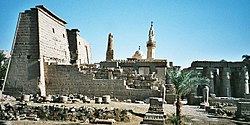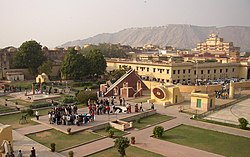2008 Watch List
The 2008 World Monuments Watch List of 100 Most Endangered Sites was announced on June 6, 2007 by WMF President Bonnie Burnham. [1] [3] The 2008 Watch List highlights three critical man-made threats affecting the world's cultural heritage: political conflict, unchecked urban and industrial development, and global climate change. [1]
On this list, man is indeed the real enemy. But, just as we caused the damage in the first place, we have the power to repair it, by taking our responsibility as caretakers of the world’s cultural heritage seriously. So today we are sounding the alarm, using the World Monuments Watch List to demonstrate, through the vivid examples of beloved places around the world, the importance of working together to meet these challenges and join forces to protect our world’s shared architectural heritage.
— Bonnie Burnham, WMF president, launch of 2008 Watch List [1]
List by country/territory













| Number [A] | Country/Territory | Site [B] | Location [C] | Period [C] |
|---|---|---|---|---|
| 1 | Afghanistan | Buddhist Remains of Bamiyan | Bamiyan Valley | ca. AD 600 |
| 2 | Afghanistan | Murad Khane | Kabul | 18th century–1920 |
| 3 | Afghanistan | Tepe Narenj | Kabul | 5th–9th Centuries AD |
| 4 | Algeria | Medracen and el-Khroub Numidian Royal Mausolea | Constantina and Batna Region | 4th–3rd Centuries BC |
| 5 | Antarctica | Scott’s Hut and the Explorers’ Heritage of Antarctica | Scott's Hut, Cape Evans, Ross Island | 1899–1917 |
| 6 | Argentina | Brener Synagogue | Moises Ville | 1909 |
| 7 | Armenia | Kumayri District | Alexandrapol, Gyumri | 19th–20th Centuries |
| 8 | Australia | Dampier Rock Art Complex | Dampier Archipelago | c. 10,000 BC–Present |
| 9 | Azerbaijan | Khinalyg Village | Guba Region | 17th–19th Centuries |
| 10 | Bangladesh | Sonargaon-Panam City | Sonargaon | 15th–19th Centuries |
| 11 | Bosnia and Herzegovina | Sarajevo City Hall | Sarajevo | 1892–1894 |
| 12 | Brazil | Porangatu Historic District | Porangatu | 18th–early 20th Centuries |
| 13 | Bulgaria | Novae Archaeological Site | Svishtov | AD 49–700 |
| 14 | Burkina Faso | Loropeni Ruins | Poni Province | 18th Century |
| 15 | Canada | Herschel Island | Yukon Territory | 1890–1907 |
| 16 | Chile | Montemar Institute of Marine Biology | Viña del Mar | 1941–1945; 1956–1969 |
| 17 | China | Modern Shanghai | Shanghai | 1920–1949 |
| 18 | China | Xumishan Grottoes | Ningxia Hui Autonomous Region | 4th–10th Centuries AD |
| 19 | Cyprus | Famagusta Walled City | Famagusta | 3rd Century BC–19th Century AD |
| 20 | Egypt | Blue Mosque (Aqsunqur Mosque) | Cairo | 14th–17th Centuries |
| 21 | Egypt | Shunet el-Zebib | Abydos | c. 2750 BC |
| 22 | Egypt | West Bank of the Nile | Luxor | Paleolithic to Modern; Main Period: New Kingdom, 1540–1075 BC |
| 23 | Eritrea | Derbush Tomb | Massawa | 16th Century |
| 24 | Ethiopia | Mohammadali House | Addis Ababa | c. 1900 |
| 25 | France | Epailly Chapel of the Order of the Temple | Courban | 1200–1330 |
| 25 | Georgia | Gelati Monastery and Academy | Kutaisi | 12th–14th Centuries |
| 26 | Ghana | The Wa Naa’s Palace | Wa | 19th Century |
| 27 | Greece | Lesvos Historic Churches | Lesvos | 5th–19th Centuries |
| 28 | Greece | Pella Macedonian Tombs | Pella | 4th–2nd Centuries BC |
| 29 | Guatemala | Ceibal Archaeological Site | Sayaxche | 300 BC–AD 250; AD 830–950 |
| 30 | Guatemala | Capitanes Generales Palace | Antigua Guatemala | 1549–1773 |
| 31 | India | Amber Town | Rajasthan | 11th–18th Centuries |
| 32 | India | Chettinad | Karraikudi, Tamil Nadu | 19th Century |
| 33 | India | Jantar Mantar (The Observatory) | Jaipur, Rajasthan | 1729; 1901 Reconstructions |
| 34 | India | Leh Old Town | Ladakh Region, Jammu & Kashmir | 15th–17th Centuries |
| 35 | India | Srinigar Heritage Zone | Srinagar, Jammu & Kashmir | 14th–19th Centuries |
| 36 | Indonesia | Kotagede Heritage District | Yogyakarta Special Territory | 16th Century |
| 37 | Iraq | Cultural Heritage Sites of Iraq | Various Locations | Prehistoric–Present |
| 38 | Ireland | Tara Hill | County Meath | 3rd Millennium BC–12th Century AD |
| 39 | Ireland | Vernon Mount | County Cork | 1780s–1950 |
| 40 | Israel, Jordan, Palestinian Territories & Syria | Jordan River Cultural Landscape | Prehistoric–AD 1516 | |
| 41 | Italy | Farnese Nymphaeum | Rome | 1565–1635 |
| 42 | Italy | Fenestrelle Fortress | Fenestrelle, Turin | 1728–1850 |
| 43 | Italy | Transhumance Cultural Landscape | Molise Region | 3rd Century BC–1945 |
| 44 | Italy | Viscontian Bridge-Dam | Valeggio sul Mincio | 1393–1397 |
| 45 | Jamaica | Falmouth Historic Town | Falmouth | 1770s |
| 46 | Jordan | Khirbet et-Tannur | Tafilah, Ma'an Governorate | 1st Century BC–2nd Century AD |
| 47 | Jordan | Qusayr ‘Amra | Al-'Azraq Municipality | 8th Century AD |
| 48 | Libya | Wadi Mathendous Rock Art | Fezzan | 8000–3000 BC |
| 49 | Macedonia | Holy Mother of God Peribleptos Church | Ohrid | 1295–1767 |
| 50 | Madagascar | Fianarantsoa Old City | Fianarantsoa | 19th Century |
| 51 | Malta | Fort St. Elmo | Valletta | 1552–1565; 1689–1877; 1900–1945 |
| 52 | Mauritania | Chinguetti Mosque | Chinguetti | 13th Century |
| 53 | Mexico | Chihuahua Missions | Chihuahua | 16th–19th Centuries |
| 54 | Mexico | Huaca Historic Neighborhood | Veracruz | 1870–1912; 1940–1950 |
| 55 | Mexico | Monte Albán Archaeological Site | Oaxaca | 500 BC–AD 850 |
| 56 | Mexico | Teuchitlán-Guachimontones Archaeological Zone | Teuchtitlán, Jalisco | 400 BC–AD 600 |
| 57 | Morocco | Al-Azhar Mosque (Ain Khail Mosque) | Fez | 12th Century |
| 58 | Nigeria | Ikom Monoliths of Cross River State | Ikom | Before 2000 BC |
| 59 | Pakistan | Shikarpoor Historic City Center | Sindh | 17th–18th Centuries |
| 60 | Palestinian Territories | Church of the Holy Nativity | Bethlehem | AD 330–Present |
| 61 | Peru | Laraos Terraces | Laraos | 1440–Present |
| 62 | Peru | Lima Historic City Center | Lima | 17th–19th Centuries |
| 63 | Peru | Machu Picchu Historic Sanctuary | Urubamba Valley | 15th Century |
| 64 | Peru | Macusani-Corani Rock Art | Macusani and Corani | 5000–2000 BC |
| 65 | Peru | San Pedro Apostol de Andahuaylillas Church | Andahuaylillas | 1570–1629 |
| 66 | Peru | Santa Catalina Monastery | Arequipa | 16th–18th Centuries |
| 67 | Russia | Church of the Icon of the Mother of God of the Sign | Teplovo | c. 1797 |
| 68 | Russia | Mendeleev Tower | St. Petersburg | 1902–1950s |
| 69 | Russia | St. Petersburg Historic Skyline | St. Petersburg | 1703–1950s |
| 70 | Senegal | Ile de Saint-Louis (St. Louis Island) | Saint-Louis | 18th–19th Centuries |
| 71 | Sierra Leone | Freetown Historic Monuments | Freetown | 17th Century |
| 72 | Slovakia | Banská Stiavnica Calvary Complex | Banská Stiavnica | 1744–1751 |
| 73 | Somalia | Las Geel Rock Art | Las Geel District | 4000–3000 BC |
| 74 | Spain | Joan Miró Foundation | Barcelona | 1975 |
| 75 | Sri Lanka | Kandy Sacred City | Kandy | c. 1470–1815 |
| 76 | Sweden | Ljungberg Hall | Borlänge (Kvarnsveden) | 1897–1898 |
| 77 | Syria | Cyrrhus (Nebi Houri) | Azaz | 230 BC–13th Century AD |
| 78 | Syria | Old Damascus | Damascus | 3000 BC–Present |
| 79 | Tanzania | Kilwa Historic Sites | Kilwa | 200 BC–AD 600; AD 700–1600; 18th–20th Centuries |
| 80 | Turkey | Çukur Han | Ankara | 16th–17th Centuries |
| 81 | Turkey | Hasankeyf | Hasankeyf | Prehistoric–14th Century |
| 82 | Turkey | Istanbul Historic Walls | Istanbul | 5th–15th Centuries |
| 83 | Turkey | Meryem Ana (Mother of God) Church | Göreme, Cappadocia | Early 11th Century |
| 84 | Turkey | Red Church | Güzelyurt, Sivrihisar, Cappadocia | 6th Century |
| 85 | Ukraine | Pidhirtsi Castle | Pidhirtsi | 17th–18th Centuries |
| 86 | United Kingdom | Mavisbank House | Midlothian, Scotland | 1720–1750 |
| 87 | United Kingdom | Richhill House | County Armagh, Northern Ireland | 1655–1698 |
| 88 | United Kingdom | Wilton’s Music Hall | London | 1858, with earlier fabric dating from the 1720s |
| 89 | United Kingdom | St. Peter’s College, Cardross | Cardross, Scotland | 1960s |
| 90 | United States of America | Florida Southern Historic Campus | Lakeland, Florida | 1938–1950s |
| 92 | United States of America | Historic Neighborhoods of New Orleans | New Orleans, Louisiana | 18th–20th Centuries |
| 93 | United States of America | Historic Route 66 | Various Cities, Towns and Villages between Chicago, Illinois and Los Angeles, California | 1926–1970 |
| 94 | United States of America | Main Street Modern | Various Locations | 1945–1975 |
| 95 | United States of America | New York State Pavilion | Flushing, New York | 1964 |
| 96 | United States of America | Salk Institute | La Jolla, California | 1959–1965 |
| 97 | United States of America | Tutuveni Petroglyph Site | Coconino County, Arizona | 1200–Present |
| 98 | Uzbekistan | Ayaz Kala | Karakalpakstan | 4th Century BC–7th Century AD |
| 99 | Uzbekistan | Madrasa Rashid | Bukhara | 15th–18th Centuries |
| 100 | Zimbabwe | Bumbusi National Monument | Matabeland | Prehistoric; 18th–19th Centuries AD |